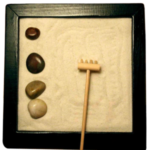Minimalism. Simply put, minimalism is stripping of an artistic work down to its most fundamental features. A word, a plain statement, that in which one understands exactly what the author is trying to portray without bells and whistles. The teachings of Zen are much like that of minimalism. Zen’s basis is about understanding the true essence, or the most fundamental feature of things, so to speak. In this essay, I hope to show how minimalism in fiction and the teachings of Zen are more similar than you would think.
Let us delve into the definitions of these two entities. Minimalism in fiction is generally characterized by a focus on ‘surface detail’ and is more of a portrayal of everyday life rather than fantasy or over the top novelization. An example of an minimalist author is Raymond Carver, who is the author of ‘Cathedral’ and ‘A Small, Good Thing’ we have read so far. Raymond Carver lived from 1938 to 1988 and was born in Oregon. He explains his works as minimalistic partially due to a seeming lack of a detail-oriented memory; ‘the kind of memory that can bring entire conversations back to the present complete with all the gestures and nuances of real speech’ . Whatever the case may be, Raymond Carver has been a poster child of minimalist fiction. He has said ‘I put the furnishings and the physical things surrounding the people into the stories as I need those things’, also ‘Nothing more than a working marriage of necessity and convenience’ which makes his brand of minimalism a great comparison to Zen teachings.
Zen, on the other hand, is a spiritual mindset that originated in India, focusing on the practice of ‘dharma’ or Buddhist teachings and experiential wisdom. Zen teachings de-emphasize theoretical knowledge and the use of ‘labels’ that clutter the mind. Focusing in upon the practice of ’emptying the mind’ which Zen stresses, in which one does not empty their mind of everything, simply the labels of objects to be able to embrace that object’s true essence. This being said, it is very difficult to explain the Zen mindset to someone who has not experienced it directly, or experienced some kind of ‘awakening’ of understanding to the subject. The woman I learned about Zen from had a good way of explaining it. She wrote the word ‘fire’ on the dry-erase board and said, ‘This is not fire. This is ‘fire’. (Implying that it’s just a word and does nothing but represent an object) If I touch it, my hand does not burn, I cannot feel the heat from this ‘fire’, I cannot light a room with this ‘fire’. (She turned the light off and back on again).’ Teachers of Zen, however, do use words and texts to help explain their beliefs, which may be hypocritical, however it would be much more difficult to transfer the knowledge without these methods. One could even say they use these as a ‘necessity and convenience’.
The work I am going to be focusing on in my comparison is Cathedral by Raymond Carver. A short synopsis of the story is a man (we’ll call him ‘Bub’ as that is the only real name he’s given in the story) who’s wife had been reading to a blind man over a summer and had kept contact with him over a period of a few years, sending him cassette tapes she had recorded talking about everyday things. She then invited the blind man, Robert, to come visit her and ‘Bub’, and while ‘Bub’ is skeptical of the whole situation, he agrees to be cordial. Robert arrives and the atmosphere was awkward. It was only after his wife went to sleep did Robert and ‘Bub’ really begin to connect. They were watching a television program on cathedrals, which brought about the question if Robert even knew what a cathedral looked like or what it was. Robert said no but convinced ‘Bub’ to draw one with him. ‘Bub’ drew and Robert followed the pencil with his hand, in the end, Robert felt what the cathedral looked like through the means of a drawing on paper. The last few paragraphs of the story are what really caught my eye in terms of the comparison to this kind of minimalism and the teachings of Zen. Robert already had a leg-up so to speak on most people who could attain innate wisdom, as Robert cannot see what objects look like; he has already surpassed one of the barriers without even really trying.
Carver’s approach to minimalism in fiction and the Zen mindset are very similar when you bring them both to light. Both offer the student the path to innate wisdom, in fiction’s sense, the ‘ultimate truth’ of the idea the author is trying to portray. Both use methods that take the least amount of wording or actual literary text, and both only use these methods by necessity and convenience. In the story Cathedral, Robert is more ‘Zen’ than the other characters because he already cannot see and therefore is already one step closer to discarding labels. You could even consider Robert a teacher, as he helps ‘Bub’ understand that you don’t have to see something to understand its true essence.
To conclude, minimalism in fiction and the teachings of Zen are, in their own way, completely different paths to the same idea. To achieve the innate wisdom of the ultimate truths of both the idea an author is portraying, and a clear eye on life, one must first strip everything to its bare essence. But in order to pass that wisdom along, one must still give the simplest and most minimal detail in a story or explanation. ‘Necessity and convenience’, as Carver said, are the fundamental idea behind the texts of both minimalist fiction and the teachings of Zen.



